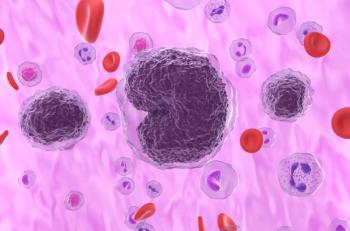
Genetic Obesity Linked With DLBCL Risk
Key Takeaways
- Obesity is associated with an increased risk of DLBCL, but not with other NHL subtypes, according to recent genetic studies.
- The study used genome-wide association studies and polygenic scores to establish a link between genetically determined BMI and DLBCL risk.
New reporting suggests obesity and diffuse large B-cell lymphoma (DLBCL) have shared genetic risk factors.
People with obesity have an increased risk of developing diffuse large B-cell lymphoma (DLBCL), according to a new report that looked at correlations between genetically determined body mass index (BMI) and the risk of
Aside from DLBCL, no other NHL subtypes had a significant association with obesity, the authors said. The study was
Previous studies have suggested that excess weight is a risk factor for B-cell lymphomas, noted corresponding author Sonja I. Berndt, PharmD, PhD, of the National Cancer Institute, and colleagues. However, they noted that the research so far is inconclusive.
For instance, a
While there is significant variance among the published reports on the topic, Berndt and colleagues wrote that the most convincing evidence has come when investigators looked at the correlation between obesity and DLBCL, specifically.1
Still, most of those previous studies have relied on BMI to define obesity, even though that metric is solely based on height and weight and may not offer the same level of precision as other markers, such as waist-to-hip ratio (WHR), Berndt and colleagues noted.
“WHR represents a different measure of adiposity that incorporates the observed protective effects of an increased femoral-gluteal muscle, and studies of cardiovascular disease have shown associations with WHR independent of BMI,” they wrote.
Moreover, if there is a connection between NHL and obesity, it may have to do with shared genetic risk factors between the 2 medical conditions, rather than a patient’s specific dimensions.
In an effort to better understand the issue, the investigators turned to 8 genome-wide association studies of 4 common subtypes of NHL in patients with European ancestry. Collectively, more than 10,000 patients and 9,500 controls were included in the genome-wide association studies. The authors then constructed polygenic scores (PGS) for BMI, WHR, and WHR adjusted for BMI (WHRadjBMI). They found that genetically determined BMI was linked with an increased risk of DLBCL (OR per SD, 1.18; 95% CI, 1.05-1.33; P = .005). However, they found no such association between genetically determined BMI and the 3 other NHL subtypes analyzed: follicular lymphoma, chronic lymphocytic leukemia, or marginal zone lymphoma.
A Mendelian randomization analysis led to complementary findings linking DLBCL risk with higher genetically determined BMI (OR per SD, 1.12; 95% CI, 1.02-1.23; P = .03).
“In this large study of genetically determined adiposity and NHL risk, we observed a positive association between genetically determined BMI and risk of DLBCL,” they wrote.
The investigators noted that the patient populations used in this analysis were not representative of all racial and ethnic groups. They said larger studies are needed to better understand the generalizability of their findings.
The authors concluded, however, that their report offers strong evidence affirming previous reports that suggest that people with obesity may be at a heightened risk of DLBCL, specifically.
“Future exploration of biological pathways that underlie the association with BMI and DLBCL is warranted as well as the evaluation of BMI with DLBCL subtypes, as these may provide insight into the etiology of NHL,” they concluded.
References
- Moore A, Kane E, Teras LR, et al. Genetically determined body mass index is associated with diffuse large B-cell lymphoma in polygenic and Mendelian randomization analyses. Int J Cancer. Published online September 5, 2025. doi:10.1002/ijc.70039
- Patel AV, Diver WR, Teras LR, Birmann BM, Gapstur SM. Body mass index, height and risk of lymphoid neoplasms in a large United States cohort. Leuk Lymphoma. 2013;54(6):1221-1227. doi:10.3109/10428194.2012.742523
- Chang ET, Hjalgrim H, Smedby KE, et al. Body mass index and risk of malignant lymphoma in Scandinavian men and women. J Natl Cancer Inst. 2005;97(3):210-218. doi:10.1093/jnci/dji012
Newsletter
Stay ahead of policy, cost, and value—subscribe to AJMC for expert insights at the intersection of clinical care and health economics.













































